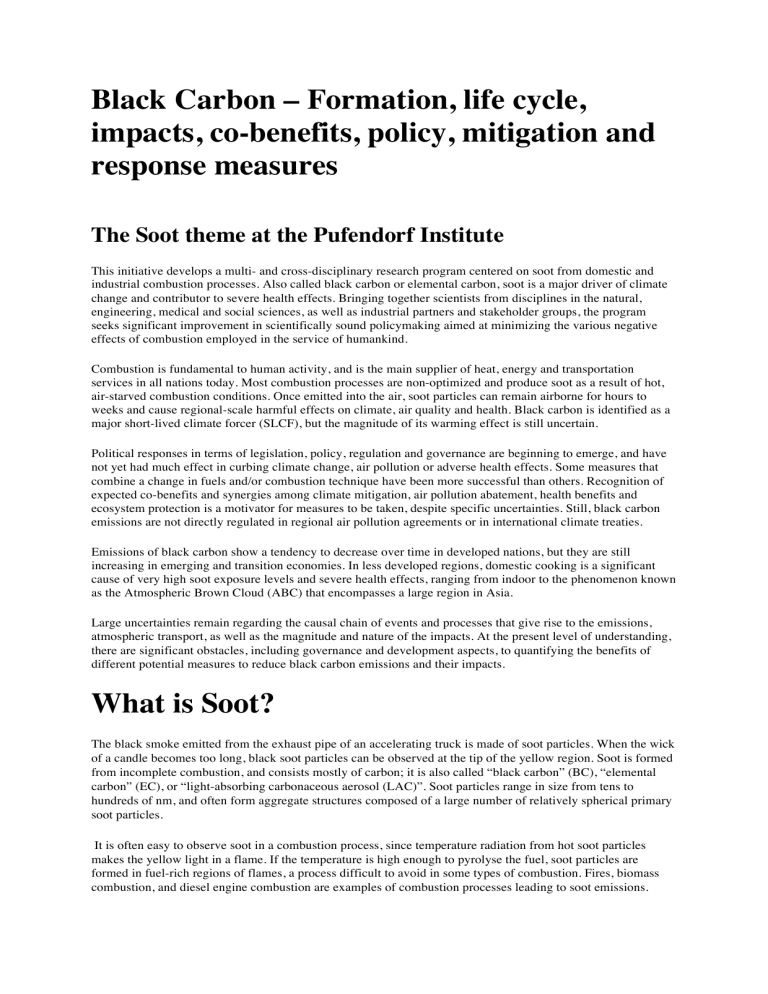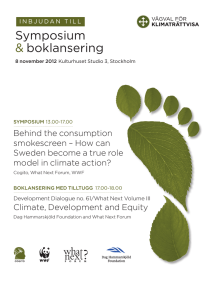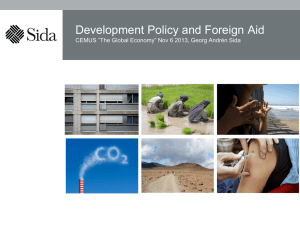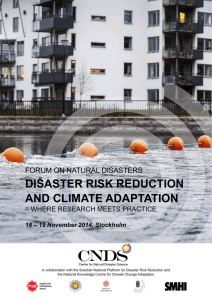Black Carbon - Pufendorfinstitutet

Black Carbon
–
Formation, life cycle, impacts, co
-
benefits, policy, mitigation and response measures
The Soot theme at the Pufendorf Institute
This initiative develops a multi- and cross-disciplinary research program centered on soot from domestic and industrial combustion processes. Also called black carbon or elemental carbon, soot is a major driver of climate change and contributor to severe health effects. Bringing together scientists from disciplines in the natural, engineering, medical and social sciences, as well as industrial partners and stakeholder groups, the program seeks significant improvement in scientifically sound policymaking aimed at minimizing the various negative effects of combustion employed in the service of humankind.
Combustion is fundamental to human activity, and is the main supplier of heat, energy and transportation services in all nations today. Most combustion processes are non-optimized and produce soot as a result of hot, air-starved combustion conditions. Once emitted into the air, soot particles can remain airborne for hours to weeks and cause regional-scale harmful effects on climate, air quality and health. Black carbon is identified as a major short-lived climate forcer (SLCF), but the magnitude of its warming effect is still uncertain.
Political responses in terms of legislation, policy, regulation and governance are beginning to emerge, and have not yet had much effect in curbing climate change, air pollution or adverse health effects. Some measures that combine a change in fuels and/or combustion technique have been more successful than others. Recognition of expected co-benefits and synergies among climate mitigation, air pollution abatement, health benefits and ecosystem protection is a motivator for measures to be taken, despite specific uncertainties. Still, black carbon emissions are not directly regulated in regional air pollution agreements or in international climate treaties.
Emissions of black carbon show a tendency to decrease over time in developed nations, but they are still increasing in emerging and transition economies. In less developed regions, domestic cooking is a significant cause of very high soot exposure levels and severe health effects, ranging from indoor to the phenomenon known as the Atmospheric Brown Cloud (ABC) that encompasses a large region in Asia.
Large uncertainties remain regarding the causal chain of events and processes that give rise to the emissions, atmospheric transport, as well as the magnitude and nature of the impacts. At the present level of understanding, there are significant obstacles, including governance and development aspects, to quantifying the benefits of different potential measures to reduce black carbon emissions and their impacts.
What is Soot?
The black smoke emitted from the exhaust pipe of an accelerating truck is made of soot particles. When the wick of a candle becomes too long, black soot particles can be observed at the tip of the yellow region. Soot is formed from incomplete combustion, and consists mostly of carbon; it is also called “black carbon” (BC), “elemental carbon” (EC), or “light-absorbing carbonaceous aerosol (LAC)”. Soot particles range in size from tens to hundreds of nm, and often form aggregate structures composed of a large number of relatively spherical primary soot particles.
It is often easy to observe soot in a combustion process, since temperature radiation from hot soot particles makes the yellow light in a flame. If the temperature is high enough to pyrolyse the fuel, soot particles are formed in fuel-rich regions of flames, a process difficult to avoid in some types of combustion. Fires, biomass combustion, and diesel engine combustion are examples of combustion processes leading to soot emissions.
Apart from the intentional production of carbon black for industrial applications (e.g. tire filler, printer toner, paint), soot production is undesirable due to effects on human and environmental health. When emitted to the atmosphere, soot particles can remain airborne for hours to weeks, are influenced by surface condensation of various substances, and undergo morphological changes. Society faces important challenges in reducing soot’s mostly negative impact on air quality, environment, human health and climate.
"Black Carbon
-
Formation, life cycle, impacts, co
-
benefits, policy, mitigation and response measures"
Workshop June 18-20, 2012
The three-day workshop is open to all those interested and is free of charge - lunch, coffee and dinner included.
Participants are welcome to submit posters and to attend all or a selection of sessions. Please note that you need to sign up for the workshop! Please do so no later than June 7using the online form by following this link:
Most welcome to Lund
Venue: Ingvar Kamprad Design Center
Time: June 18-20, 2012
About the workshop
Soot (or BC: "Black Carbon") is one of the short-lived climate forcers (SLCF). The Swedish Minister of the
Environment, Lena Ek, together with the US Secretary of State Hillary Clinton and others in Washington, recently launched a global initiative in order to decrease emissions of SLCF, soot included.
Considering the recent interest in the SLCF we arrange a workshop at Lund University, Sweden. The focus of this workshop is on soot (BC).
The purpose of the workshop is to:
· Summarize the state of knowledge regarding the effects of soot (BC) on climate and human health
· Map the fields of research, within and across disciplines, that need to be addressed in order to fulfill the requirements of society
· Establish a dialogue between scientists in relevant disciplines and the stakeholders of our society
· Outline a roadmap for how research on the climate and health effects of soot should be conducted and financed
This workshop is arranged within the framework of an interdisciplinary research initiative at the Lund University
Pufendorf Institute, and the Lund University Centre for Environmental and Climate Research (CEC), including the Swedish Strategic Research Area MERGE.
About the workshop (in Swedish)
Sot (eller BC: "Black Carbon") är en av de kortlivade klimatpåverkande luftföroreningarna (SLCF).
Miljöminister Lena Ek har i Washington tillsammans med bland andra USAs utrikesminister Hillary Clinton
lanserat ett globalt initiativ för att minska utsläppen av SLCF, däribland sot.
Med anledning av det stora intresset för dessa SLCF så anordnar vi en workshop vid Lunds universitet. Fokus för denna workshop ligger på sot (BC).
Syftet med detta möte är att:
· Sammanställa kunskapsläget rörande klimat- och hälsoeffekter av sot (BC)
· Kartlägga vilka inom- och tvär-vetenskapliga forskningsbehov som finns för att svara på samhällets behov
· Få till stånd en dialog mellan forskare inom olika relevanta discipliner och samhällets aktörer
· Dra upp riktlinjer för hur forskningen kring sotets klimat- och hälsoeffekter ska bedrivas och finansieras
Denna workshop anordnas inom ramen för ett tvärdisciplinärt forskningsinitiativ vid Pufendorfinstitutet, Lunds universitet, samt det strategiska forskningsområdet MERGE.
Samordning sker med Institutionen för Tillämpad Miljöforskning vid Stockholm universitet och SMHI, som har
Regeringens uppdrag att samordna arbetet med SLCF inom Sverige. http://www.smhi.se http://www.itm.su.se/slcf
Några av de frågeställningar som ska belysas under detta möte är:
· Är sotet farligt för människors hälsa, eller är det en eller flera andra luftföroreningar som släpps ut samtidigt med sot som orsakar hälsoeffekterna?
· Kan vi på ett trovärdigt sätt uppskatta sotets värmande effekt?
· Hur mäter vi halter och utsläpp av sot från olika typer av förbränning?
· Om vi begränsar utsläppen av sot, begränsar vi då samtidigt utsläppen av andra partiklar som kyler vår planet?
· Hur påverkas övriga emissioner av SLCF och vilka samverkande åtgärder finns och är möjliga.
· Hur säkerställer vi att förbränning av de förnybara bränslena inte orsakar ökande utsläpp av sot i framtiden?
· Vilka styrmedel behövs för att uppnå minskade utsläpp av sot, och vilka tekniska lösningar finns att tillgå?
Erik Swietlicki, Lunds universitet
Markku Rummukainen, Lunds universitet
Joakim Langner, SMHI
Hans-Christen Hansson, Stockholms universitet
A future large
-
scale black carbon research program
Tentative elements for a soot research program are outlined below, including areas such as laboratory and field experiments, modeling, human health effects, climate impacts, and policy and regulatory response. Because our current socio-economic structures are the main driving forces behind soot emissions, structures, behavioral patterns and policies for air pollution, energy, health and climate change at the national, EU, regional, and global levels also need to be covered.
WP1 – Socio-‐economic drivers
This work package will analyze socio-economic driving forces giving rise to soot emissions from the most polluting and harmful activities. This includes an analysis of the current socio-economic driving forces to soot emissions as well as the role of technical innovation as a factor influencing soot emission levels. Potential results include material for educational resources that will help to reshape social behavior and strategies for both mitigation and adaptation, and will target the most relevant sectors of society.
WP2 – Soot formation processes in combustion and emissions
Through a combination of laboratory measurements and modeling, the physical and chemical kinetics of the soot formation stages that take place during the actual combustion process will be elucidated. Furthermore, soot emissions from various combustion sources and fuels (fossil fuels, biofuels) and sectors (energy/heat production, transportation) will be characterized and quantified.
WP3 – Soot ageing and transformation
Atmospheric ageing and transformation of soot drastically modifies the physico-chemical and optical properties of the emitted soot particles, and thus also their impacts on climate, environment and human health. This ageing will be studied in controlled laboratory experiments and at field sites and parameterized for their incorporation in models operating in a wide range of spatial and temporal scales.
WP4 – Air quality, exposure and deposition
With emission and ageing data from WP3 and WP4, atmospheric and indoor concentration fields of, and population exposure to, soot and related species in the human environment will be measured and modeled.
WP5 – Health impacts of soot exposure
The effects of soot exposure on human health will be quantified by means of the outcome in WP4 and new exposure-dose-response relationships.
WP6 – Environmental impact
Direct and indirect effects of black carbon on biological systems ranging from cell to ecosystem level will be modeled, tested and validated in laboratory and field studies.
WP7 – Climate impact
The impact of airborne and deposited soot on regional/global climate will be quantified, by means of the combination of measurement (WP8) and modeling (WP3, WP9).
WP8 – Measurement Tools
In-situ and remote sensing measurement techniques for soot characterization will be developed and used in laboratory and field studies.
WP9 – Modeling Tools
This WP will develop, evaluate, compare, merge and apply models of relevant processes covering the entire range of spatial and temporal scales.
WP10 – Policy regulation, governance and strategies
This WP will map and critically examine emerging policies and scientific assessment processes on black carbon with the aim to provide policymaking support on how to regulate black carbon in national, regional and multilateral settings. Work on risk assessment will form an important basis for the development of optimal strategies for combined air quality improvements and climate change mitigation. The work package will also analyze the implementation and effectiveness of existing regulative or policy tools to reduce the effects of black carbon, with a focus on national and EU-level policies and driving forces, including the EU's international position to soot-related issues.
Pufendorf Soot Initiative in Conversations with European Environmental Agency
On the 16th of January members of the Soot initiative at Lund University’s Pufendorf
Institute visited the European Environmental Agency (EEA) to initiate conversations about needs for scientific research and information to help advance and support policy efforts to regulate and reduce soot pollution. A dozen members of the EEA, representing different disciplinary and national backgrounds, joined in an exchange of presentations, experiences and questions in relation to soot. Policy makers and researchers agreed on the importance of advancing research and policy that connects health related impacts of soot with climate change roles of soot. This calls for integration of research and measurement efforts from diverse fields, as well as policy and legal developments that challenge conventional borders. During spring 2012, members of the soot initiative will continue to explore research and policy needs and options, together with the EEA and other relevant actors, culminating in a public seminar on issues in soot, health and climate change June 18-20.
Researchers
The platform engages researchers from four faculties at Lund University: the Engineering Faculty, LTH
(Combustion Physics, Nuclear Physics, Ergonomics and Aerosol Technology, Combustion Engines), Faculty of
Natural Sciences (Physical Geography and Ecosystems Analysis, Ecology, Biochemistry and Structural Biology,
Department of Cell and Organism Biology), Medical Faculty (Occupational and Environmental Medicine), and the Faculty of Social Sciences (Department of Sociology of Law, Department of Political Science). There are strong links to several already existing Centers of Excellence and Strategic Research Environments at Lund
University with close relevance to the soot platform.
Johanna Alkan Olsson
Researcher, Sociology of Law
Phone: +46 46-2228753
Johanna.Alkan_Olsson@soclaw.lu.se
Öivind Andersson
Universitetslektor, Combustion Engines
Phone: +46 46-2228525
Oivind.Andersson@energy.lth.se
Per-Erik Bengtsson
Professor Combustion Physics
Phone +46 46 222 3109 per-erik.bengtsson@forbrf.lth.se
Olof Berglund
Senior Lecturer, Aquatic Ecology
Phone: +46 46-2223750
Olof.Berglund@biol.lu.se
Henrik Bladh
Project leader, Combustion Physics
Phone: +46 46-2220353
Henrik.Bladh@forbrf.lth.se
Karin Bäckstrand
PhD Associate Professor/Docent
Department of PoliticalScience
Phone: + 46 46 222 47 63
Karin.Backstrand@svet.lu.se
Kristina Jakobsson
Docent, verksamhetschef, överläkare, Division of Occupational and Environmental Medicine
Phone: +46 46-173177
Kristina.Jakobsson@med.lu.se
Per Fredrik Johansson
Assistant Professor, Functional Zoology
Phone: +46 46-2229351
Per_Fredrik.Johansson@biol.lu.se
Martin Kanje
Professor, Functional Zoology
Phone: +46 46-2229577
Martin.Kanje@biol.lu.se
Joakim Pagels
PhD, Research Associate, Ergonomics & Aerosol Technology
Phone: +46 46 222 16 88
Joakim.Pagels@design.lth.se
Markku Rummukainen
Biträdande prefekt, Centre for Environmental and Climate Research (CEC)
Phone: +46 46-2229684
Koordinator, MERGE
Tel: 046-2229684
Markku.Rummukainen@cec.lu.se
Emilie Stroh
Yrkeshygieniker, Division of Occupational and Environmental Medicine
Phone: +46 46-173820
Emilie.Stroh@med.lu.se
Erik Swietlicki
Professor, Nuclear Physics
Phone: +46 46-222 96 80 erik.swietlicki@nuclear.lu.se
Håkan Tinnerberg docent, sektionschef, yrkeshygieniker, Division of Occupational and Environmental Medicine
Phone: +46 46-177045
Hakan.Tinnerberg@med.lu.se


